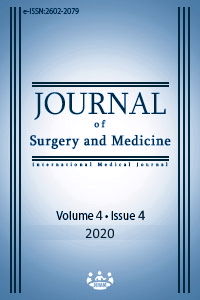Evaluation of knowledge and behavior of nurses working in intensive care units for endotracheal aspiration application
Keywords:
Intensive care, Nurse, Endotracheal aspiration, Knowledge, BehaviorAbstract
Aim: Endotracheal aspiration is one of the most common invasive procedures administered by intensive care nurses in patients receiving mechanical ventilation to provide and maintain adequate oxygenation, alveolar ventilation, and gas exchange, prevent pulmonary consolidation and atelectasis, and reduce the risk of ventilator-associated pneumonia. When the endotracheal aspiration procedure is not administered correctly, the patient may have serious complications such as arterial and venous desaturation, cardiac arrhythmia, cardiac arrest, atelectasis, bronchospasm, lower respiratory tract contamination, ventilator-induced pneumonia, anxiety, and dyspnea. The study aims to evaluate the knowledge and behaviors of nurses working in intensive care units for endotracheal aspiration applications.
Methods: This study used a cross-sectional and descriptive design including a questionnaire-based nurse survey. It was conducted between 17 March 2015-30 June 2015 with 54 nurses working in intensive care units in a public hospital. In the study, the data were collected with a questionnaire, endotracheal aspiration information form, and nurse observation form for endotracheal aspiration. The evaluation of the data was conducted using numbers and percentages. The ethics committee approval, institutional permission, and participant consent were obtained before starting the research.
Results: It was determined that the nurses participating in the study were incompetent before, during, and after the endotracheal aspiration procedure and that they did not have sufficient information about endotracheal aspiration.
Conclusion: In line with the results of the study, it was suggested that the nurses should be trained on endotracheal aspiration, the effect of education on practice should be evaluated, and that standardization studies should be carried out to minimize deficient and erroneous practices in endotracheal aspiration.
Downloads
References
Cengiz H. Yoğun bakım hastalarında görülen ventilatör ilişkili pnömoninin azaltılmasında hemşirelere verilen eğitimin etkinliği. İstanbul Üniversitesi Sağlık Bilimleri Enstitüsü, Doktora Tezi. 2017.
Er F. Yoğun bakım hemşirelerinin açık endotrakeal aspirasyon uygulamalarının izlenmesi ve hata odaklı kısa süreli bilgilendirmenin uygulamaya etkisinin incelenmesi. Adnan Menderes Üniversitesi Sağlık bilimleri Enstitüsü, Yüksek Lisans Tezi, 2017.
Irajpour A, Abbasinia M, Hoseini A, Kashefi P. Effects of shallow and deep endotracheal tube suctioning on cardiovascular indices in patients in intensive care units. Iranian Journal of Nursing and Midwifery Research. 2014;19(4):366-70.
Sole ML, Bennett M, Ashworth S. Clinical indicators for endotracheal suctioning in adult patients receiving mechanical ventilation. Am J Crit Care. 2015;24(4):318-24.
Day T, Farnell S, Haynes S, Wainwright S, Wilson-Barnett J. Tracheal suctioning: an exploration of nurses’ knowledge and competence in acute and high dependency ward areas. J Adv Nurs. 2002;9(1):5-45.
Kelleher S, Andrews T. An observational study on the open-system endotracheal suctioning practices if critical care nurses. J Clin Nurs. 2008;17(3):360-9.
Ansari A, Alavi NM, Hajbagheri MA, Afazel M. The gap between knowledge and practice in standard endo-tracheal suctioning of ICU nurses, Shahid Beheshti Hospital. Iran J Crit Care Nurs. 2012;5(2):71-6.
Özden D, Görgülü S. Development of standard practice guidelines for open and closed system suctioning. J Clin Nurs. 2012;21(9-10):1327-38.
Çelik SŞ, Elbaş NÖ. The standard of suction for patients undergoing endotracheal intubation. Intensive and Critical Care Nursing. 2000;16(3):191-8.
Maraş GB, Güler EK, Eşer İ, Köse Ş. Knowledge and practice of intensive care nurses for endotracheal suctioning in a teaching hospital in western Turkey. Intensive and Critical Care Nursing. 2017;39:45-54.
Özden D. Bir devlet hastanesinde açık ve kapalı sistem aspirasyon yöntemleri için standart geliştirilmesi ve bu yöntemlerin hastaların hemodinamik durumuna etkisinin belirlenmesi. Hacettepe Üniversitesi Sağlık Bilimleri Enstitüsü, Doktora Tezi. 2007.
Potter PA, Perry AG, Stockert P, Hall A, Astle BJ, Duggleby W. Cardiopulmonary Functioning and Oxygenation. In: Canadian Fundamentals of Nursing. 6th Edition, Canada: Elsevier Health Sciences, 2018. pp. 3163-71.
Elbokhary R, Osama A, Al-khade M. Knowledge and practice of ICU nurses regarding endotracheal suctioning for mechanically ventilated patients in Khartoum Teaching Hospital. American Journal of Clinical Neurology and Neurosurgery. 2015;1(2):92-8.
Şenol S. Endotrakeal aspirasyon uygulanan hastalarda aspirasyon standardı. Hacettepe Üniversitesi Sağlık Bilimleri Enstitüsü, Doktora Tezi, 1998.
Akgül S. Endotrakeal aspirasyonda serum fizyolojiğin etkileri. Yüksek Lisans Tezi, Danışman: Doç. Dr. Neriman Akyolcu, İstanbul, 2000.
Aslan FE, Karadağ Ş. Yoğun bakım ünitesinde hemşireye hastanın yerine düşünme ve hissetme zorunluluk ve sorumluluğu yükleyen bir sorun. Yoğun Bakım Hemşireliği Dergisi. 2007;11(2):89-95.
Sevinç S. Hemşirelerin trakeal aspirasyona karar verme durumları, uygulama biçimleri ve bunu etkileyen faktörler. Hacettepe Üniversitesi Sağlık Bilimleri Enstitüsü, Doktora Tezi, 1997.
Downloads
- 754 1210
Published
Issue
Section
How to Cite
License
Copyright (c) 2020 Safure Bozan, Şefika Dilek Güven
This work is licensed under a Creative Commons Attribution-NonCommercial-NoDerivatives 4.0 International License.
















